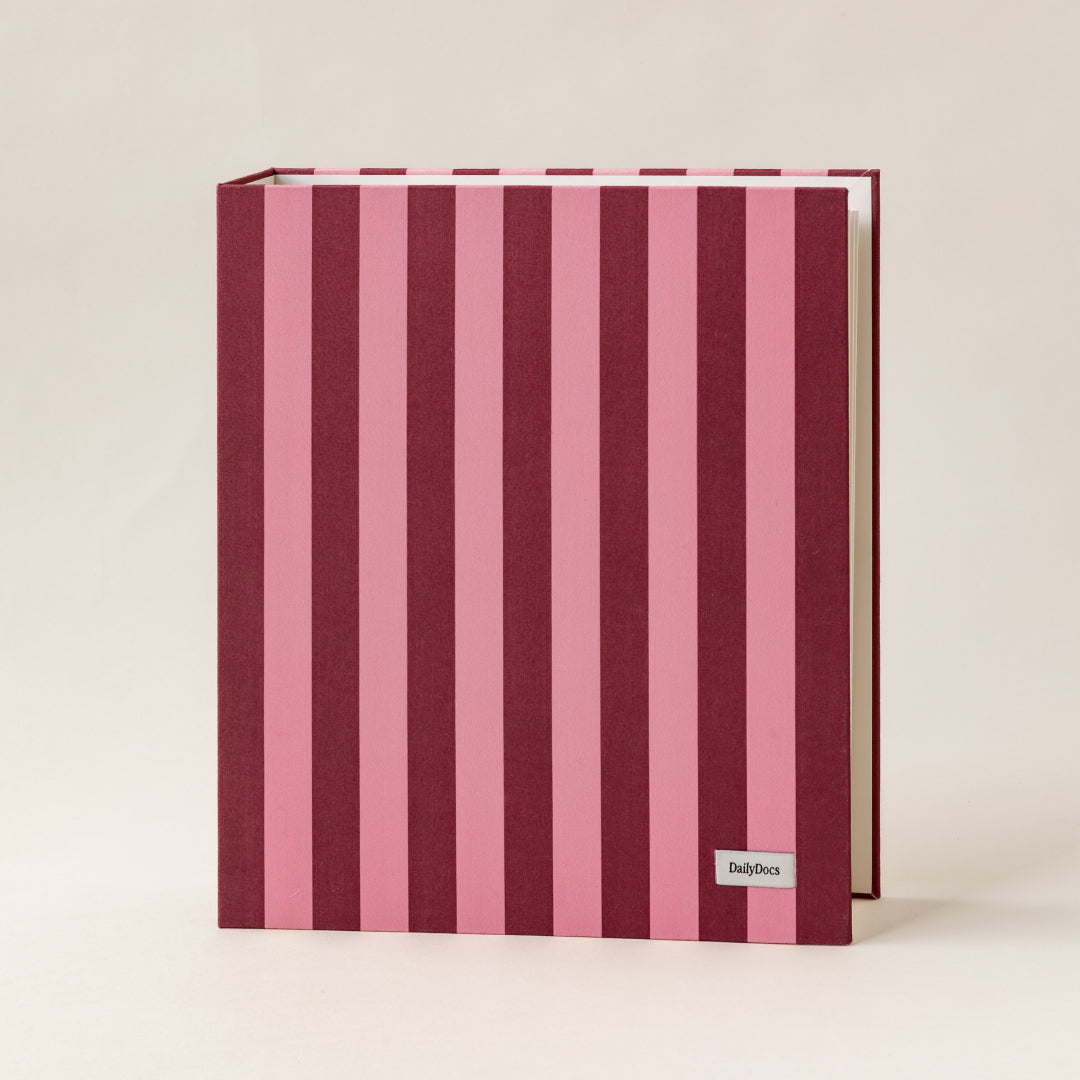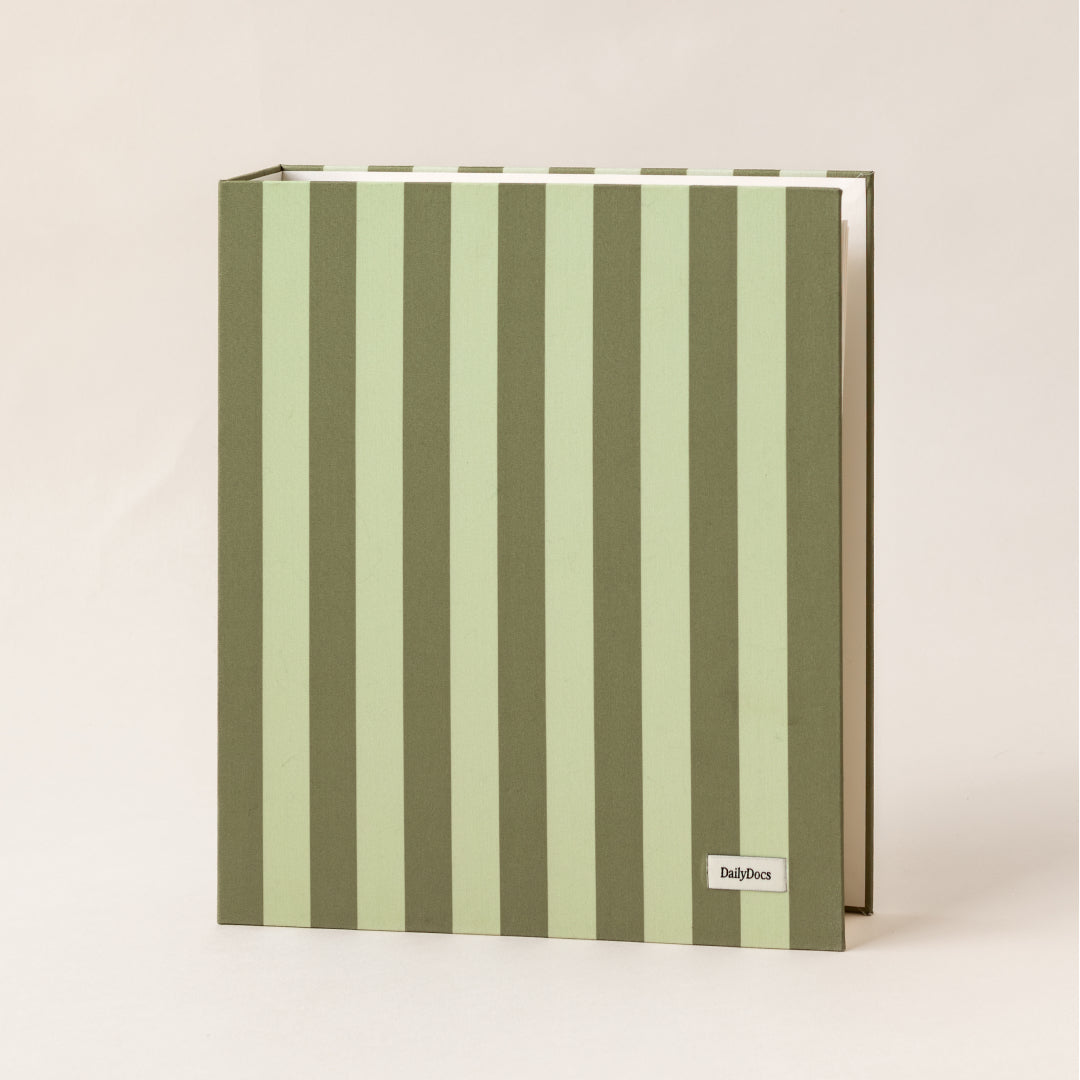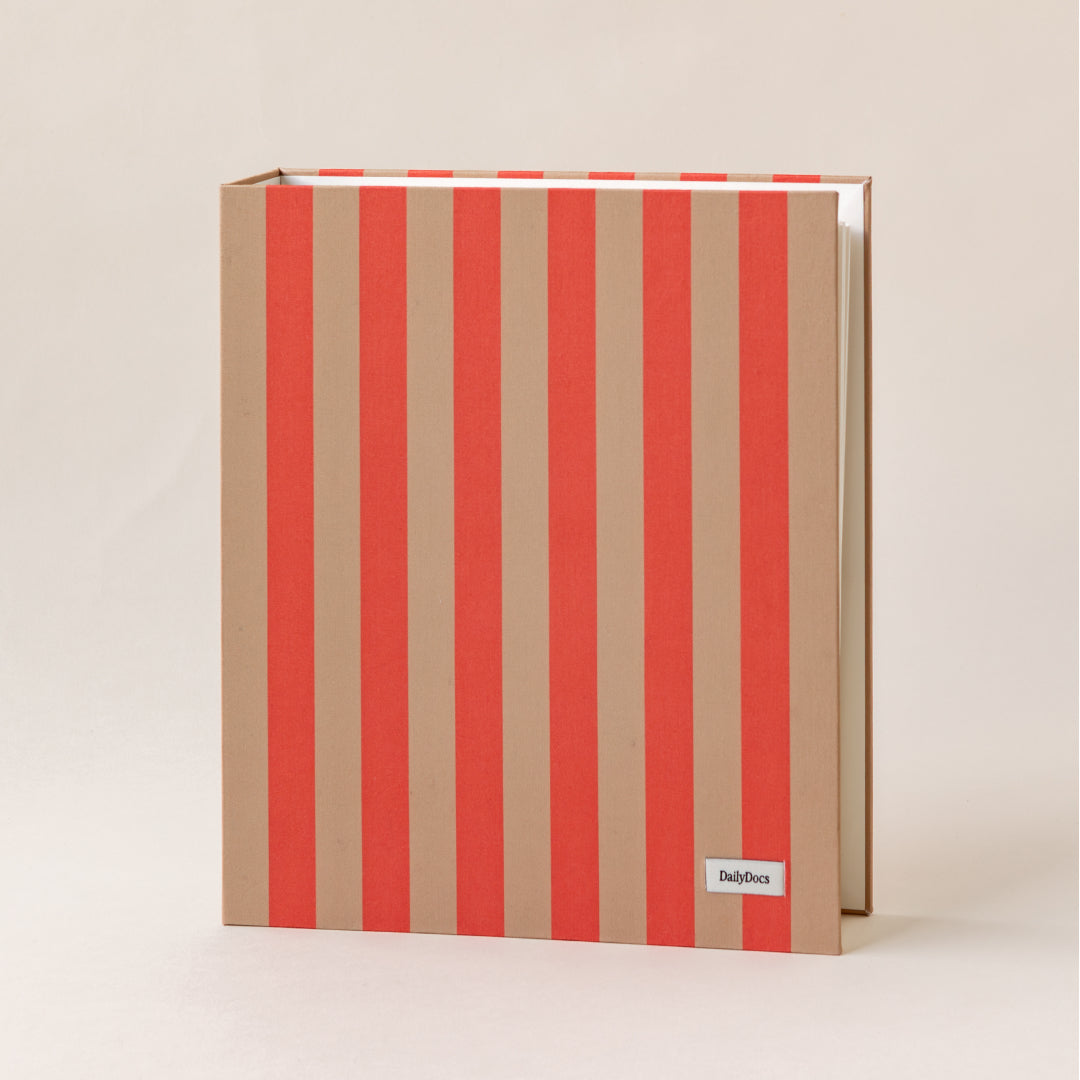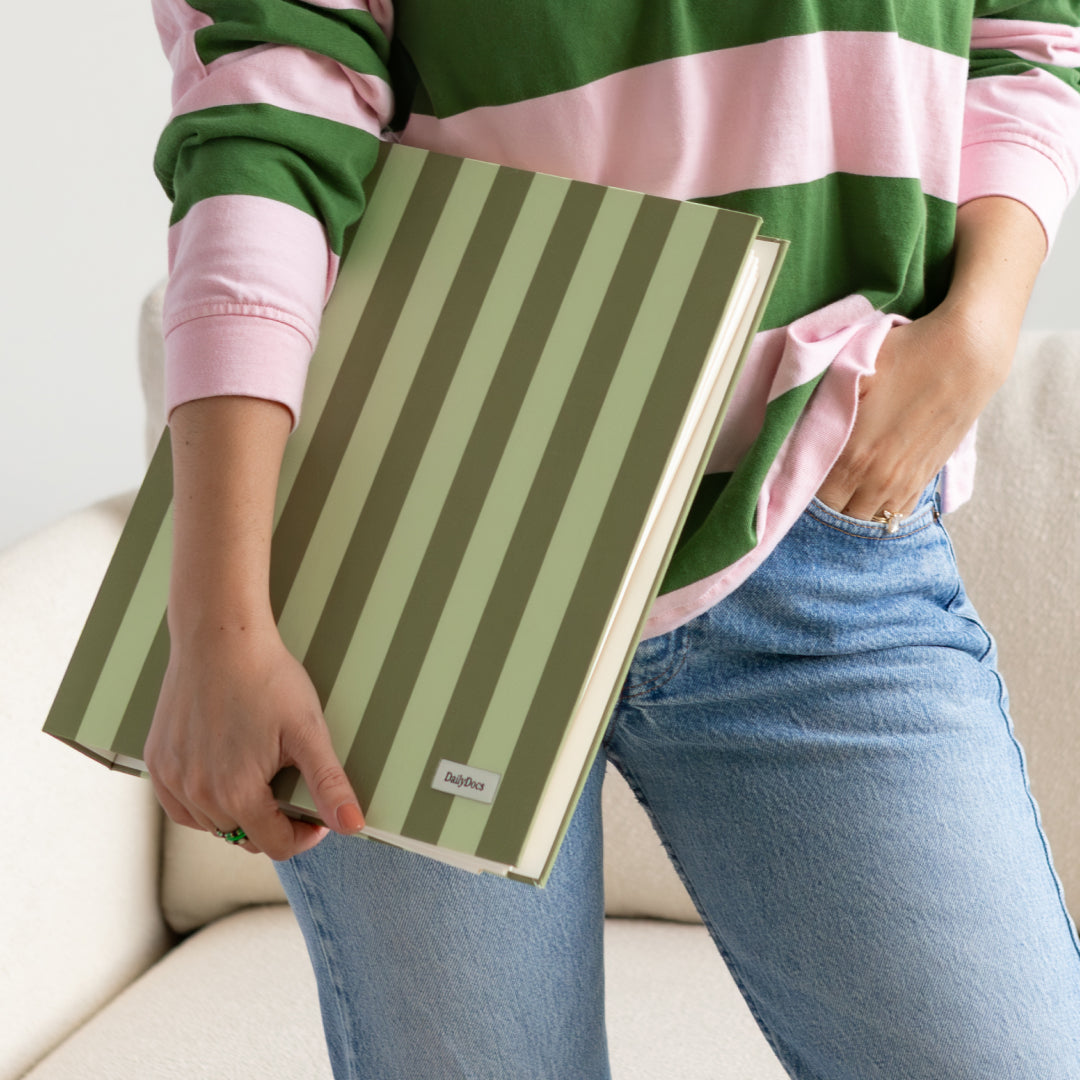Emergency Binder
We all hope life’s unpredictable twists never come knocking, but if they do, being prepared can make all the difference. Massive transitions are often accompanied by a surprising number of forms, account updates, and endless paperwork. When life decides to flip the script, an emergency binder can help you locate all your important information within minutes.
Quick-Start Checklist: Supplies You’ll Need
Before you start building your household emergency binder, let’s make sure you’ve got your toolkit prepped. You don’t need anything fancy; just some thoughtfully chosen basics that’ll help keep your fundamental paperwork safe and accessible in any situation. Here’s a simple checklist to get you going:
- Sturdy Four-Ring Binder: A 2 to 3 inch binder is usually the sweet spot for organizing most paperwork.
- Plastic Sheet Protectors: These waterproof inserts are necessary for safeguarding original documents and printouts. Alternatively, you could laminate your paperwork.
- Tabbed Dividers: Use these to separate sections like identification, medical, financial, and household information for easy navigation.
- Secure Closures: Ideal for holding small essentials like spare keys, USB drives, or handwritten memos.
- Sticky Notes And Pens: Perfect for jotting down reminders, deadlines, or quick updates right in your binder.
- Access To A Printer: Essential for printing forms, instructions, or extra copies for a physical emergency info binder.
- Hole Puncher: This helps keep all your paperwork binder-ready, uniform, and neatly stored.
- Flash Drive or Encrypted USB Stick: If you’d like to go the extra mile, offline storage provides a secure way to store digital backups of your binder contents for ultimate peace of mind.
Having all these supplies within arm’s reach will set you up for smooth sailing as you put together your emergency binder. Going through this checklist beforehand gives you a few less things to worry about as you gather your documents.
Must-Have Personal IDs And Vital Records
When your life gets turned upside down, it’s all too easy to forget just how many pieces of paper keep things running. An emergency binder isn’t complete unless it brings together every document that proves you are, unarguably, you. Here are the necessities you should securely store:
- Birth Certificate: The foundation of your identity. Having an official copy on hand is sometimes step one for a major life update, such as applying for your adult passport.
- Social Security Card: This tiny piece of paper packs a serious punch. It’s needed for everything from jobs to government benefits, so you’ll want it to be in a secure place but still accessible.
- Passport (And Passport Card, If Applicable): Your passport isn’t just for travel. It often serves as your strongest form of government-issued photo ID in sticky situations.
- Driver’s License or State ID: For daily use and for proving residency, this one’s a must.
- Marriage Certificate, Divorce Decree, or Court Order for Name Change: These are your golden tickets for updating your name. They are often the only legal name change document most institutions will accept.
- Current and Expired IDs: Ever tried to update your info without an old ID? Sometimes, that backup can be a lifesaver for stubborn bureaucracies.
- Pets and Dependent Documents: If you have children, pets, or dependents to include in your family emergency binder, add their birth certificates, Social Security cards, custody paperwork, emergency contacts, school records, immunization records, pet microchip numbers, and vet details.
- Medical Details: Keep a record of immunizations, prescriptions, allergies, health conditions, and provider contact info. This can be life-saving during an emergency or hospital visit.
- Insurance Policies: Include health, life, home, auto, and any supplemental policies. File policy numbers, coverage details, and contact info so you’re not scrambling after an incident.
- Money Matters (Accounts, Bills, and Budgets): Document your checking, savings, retirement, and investment accounts, plus monthly bills, debts, and budget notes to keep your finances in order.
- Passwords, Logins, and Digital Life: Store a printed copy of your password manager backup or a securely written list of your key logins. Think bank, insurance, utilities, and email details.
- Home and Auto Info: Include mortgage or lease agreements, car titles, maintenance records, and home inventory lists in case you need them for insurance claims.
- End-Of-Life Wishes: Add your will, power of attorney, healthcare directives, and burial/cremation preferences so your loved ones don’t have to make tough calls alone.
We highly recommend that you make physical and digital copies of each document and tuck the originals away somewhere fireproof and waterproof, like a safe. Your future self will thank you when one small snag doesn’t slow down your whole process.

Where To Store Your Emergency Binder And Who Gets A Copy
Once your emergency binder is set up, the next important step is figuring out where to keep it. This binder holds your most essential information, so it needs to be both secure and easy to access when you need it. Start by choosing a storage spot in your home that’s safe but not so hidden that you forget about it (yup, we’ve all hidden things too well at some point). A fireproof and waterproof safe is a great option because it protects against the unexpected. If that’s not available, a locked file cabinet or drawer works well too. Just avoid areas prone to moisture or heat, like the attic, garage, or near windows, since humidity and sunlight can damage documents over time.
Who Should Have Access
Now that your binder is protected, decide who should know about it. At minimum, tell a trusted family member or close friend where your binder is stored and how to access it. They don’t need to memorize every detail; just where to find it and what it’s for.
If you want an extra layer of backup, consider creating a duplicate copy to store off-site at a relative’s home or even in a safe deposit box at your bank. Some people also create a digital version with secure encryption for added peace of mind.
Why It Matters
A little extra effort here means you and the people who care about you can breathe easier knowing that everything is organized and ready to go. In an emergency, it ensures your documents are right where they need to be.
Real-Life Moments When A Binder Saves The Day
Picture this: you’re in the middle of a hectic move, cardboard boxes stacked sky-high, and suddenly your new landlord calls, needing proof of your most recent address update. Or maybe you’re at the DMV and the clerk asks for a vital form… but which folder, app, or pile is it buried in? If you’re looking to bundle up everything you need in one place, an emergency binder may be exactly what you need. Think of it as your own personal HQ for life’s biggest administrative moments. It’s not only necessary for name changes, but also any other major life shift like buying a house, switching jobs, filing taxes, or dealing with a family emergency.
- The Medical “What If”: You rush to urgent care in the middle of the night, not thinking straight, and the intake nurse asks for your insurance and emergency contact info. Instead of fumbling through apps and emails, you remembered to grab your emergency binder before heading out the door. Everything (insurance cards, allergies, prescriptions, doctor contacts) is tabbed, highlighted, and right in reach.
- Sudden Name Change Proof: Out of nowhere, HR emails about payroll. They need your updated name information ASAP. Instead of digging through random Gmail folders or scrolling through your phone, you reach for your trusty binder. Inside are your marriage certificate or divorce decree, your NewlyNamed name change kit, and a neatly organized name change checklist. Every official form and instruction is right where you need it, ready to copy, scan, or fax on the spot.
- Family Emergencies: In stressful moments, like helping a parent after a fall or comforting a loved one in a crisis, every second counts. Your binder holds power of attorney forms, medical directives, and contact lists, so you spend less time searching and more time supporting.
- Tricky Travel Situations: Maybe you’re at the airport and you need documentation for a recent name change. No panicked emails or frantic drives back home are needed. Just a calm flip of a tab or a stress-free phone call to your husband and you’re back in line, ready to go.
Having all your important records labeled and easily accessible transforms these frustrating moments into experiences you can handle while keeping your cool. That’s exactly what you want when life throws a curveball.
When And How To Update Your Emergency Binder
An emergency binder isn’t a one-and-done project. It’s a living document meant to grow and adapt with you. Life changes fast, and so does the information you’ll want to keep on hand. Knowing when and how to update your binder is key to keeping it relevant and useful.
When To Update
Here are some pivotal moments when you’ll want to break out your binder and give it a tune-up:
- After Major Life Events: Got married, divorced, or had a baby? Any change in family status is a big deal for your paperwork.
- Moving To A New Address: Whether it’s across town or across the country, a new address ripples through your records.
- New Job Or Retirement: Employment details, benefits, and emergency contacts may all need a refresh if you’re switching companies or retiring.
- Getting Or Renewing Documents: Passports, driver’s licenses, and insurance cards can all expire, so your binder should reflect those changes.
- Annual Checkup: Even if nothing major has changed, set a calendar reminder to review your binder at least once a year.
How To Update
Think of your binder like a favorite playlist. It needs regular edits to keep it current.
- Gather New Documents: As you receive new or updated paperwork, add the originals or protected copies to the correct section.
- Remove Outdated Info: Shred anything that’s expired or no longer relevant, like old insurance cards.
- Double-Check Contacts: Make sure emergency contacts, doctors, and account managers are still accurate.
- Password Updates: If you’re tracking logins or digital accounts, swap in any new passwords and clean up old ones.
- Label Changes: If your name, phone number, or any other crucial detail changes, update those sections right away.
- Print Or Back Up Digital Files: For binders living in the cloud, download the latest versions. For physical binders, reprint any updated information and slip it into your tabs.
Making your emergency binder a monthly or yearly habit means that when you need it most, it’s up to date and ready to help.
Read also:
Why do I need an emergency binder?
An emergency binder keeps all of your most important documents and information in one place, so you’re prepared if the unexpected happens. Think: natural disasters, sudden hospital visits, or even just those “where did I put that?” moments. Whether you’re in the middle of a name change or just want to be organized for life’s unpredictable events, having an emergency binder gives you peace of mind and makes it way easier for loved ones to find everything they need.
Who should have access to my emergency binder?
You’ll want at least one trusted person to know where your binder is and how to access it. Your spouse, a close family member, or a best friend are all solid options. These are the folks who may need to help you in a pinch, so keep them in the loop. But only give access to those you absolutely trust.
Where should I store my emergency binder?
The sweet spot is somewhere safe and easy to grab. A fireproof safe or a locked filing cabinet at home are both strong choices. If you’ve gone digital with copies, password-protect those files or use secure cloud storage. Avoid tossing your emergency binder in random places or leaving it in your car. The goal is to ensure it’s convenient for you to grab in an emergency, but not so accessible that anyone can stumble upon it.
How do I protect sensitive information in my emergency binder?
Store your emergency binder in a secure location like a locked safe that only you and your spouse know the combination to. Only include copies of documents if you’re worried about originals being lost or stolen, and leave out anything you don’t absolutely need. For added peace of mind, some people black out or obscure extra-sensitive numbers with sticky notes or removable covers.
Should I include contact information in my emergency binder?
Of course! Up-to-date contact info for close family members, insurance companies, and doctors is super helpful in a crisis. This way, if a stranger needs to help you, they have the numbers and emails they need.
Is an emergency binder different from a go-bag?
Absolutely. Your emergency binder is about important personal and legal documents. A go-bag, on the other hand, is packed with physical supplies like snacks, water, and flashlights for fast evacuations. Ideally, you want both: a go-bag with your emergency binder inside makes you extra prepared.





